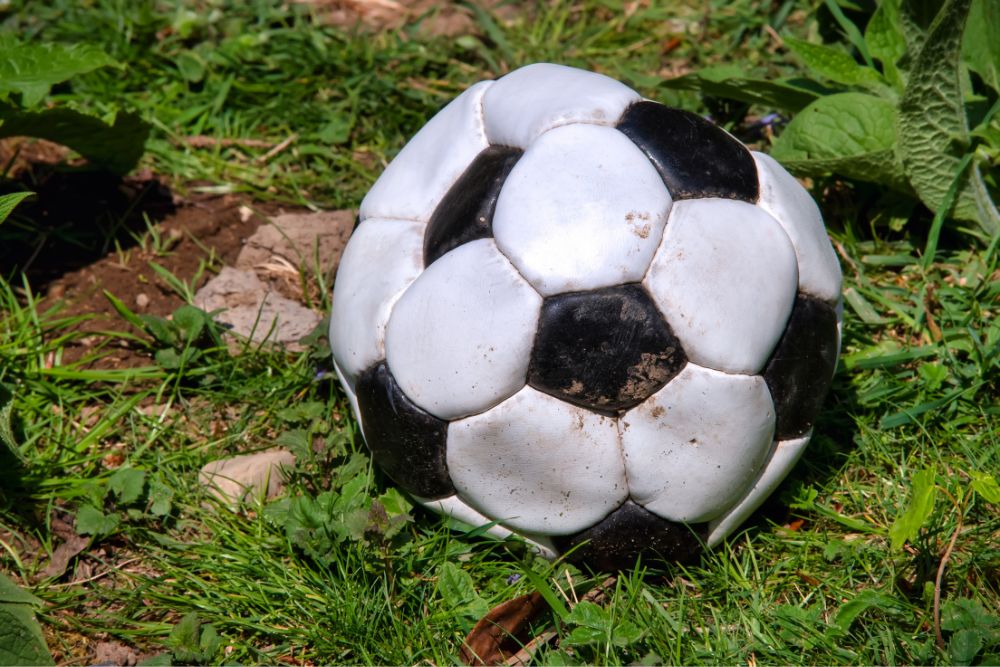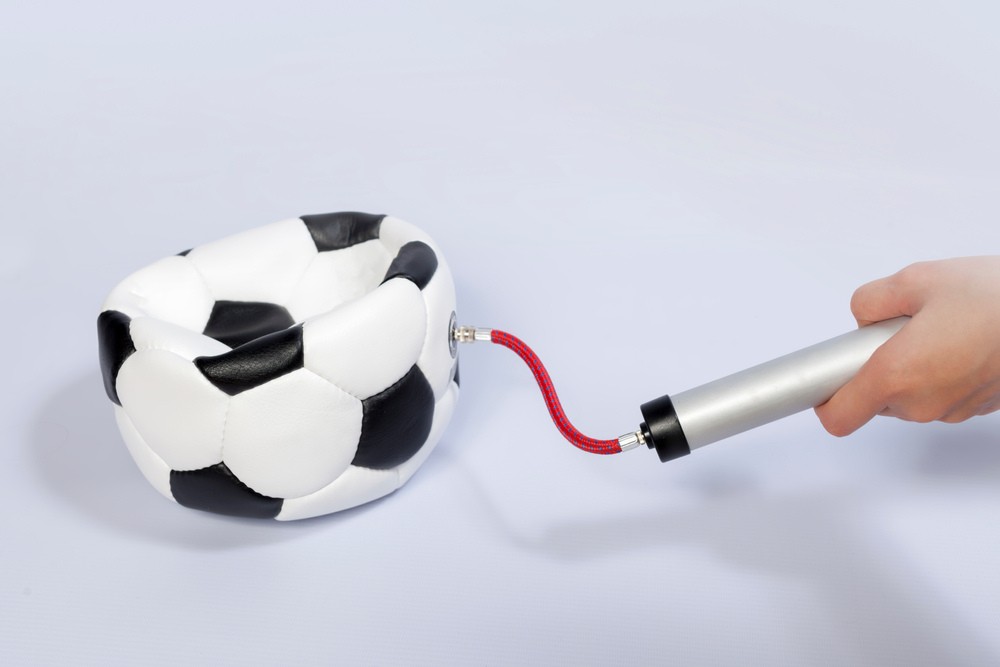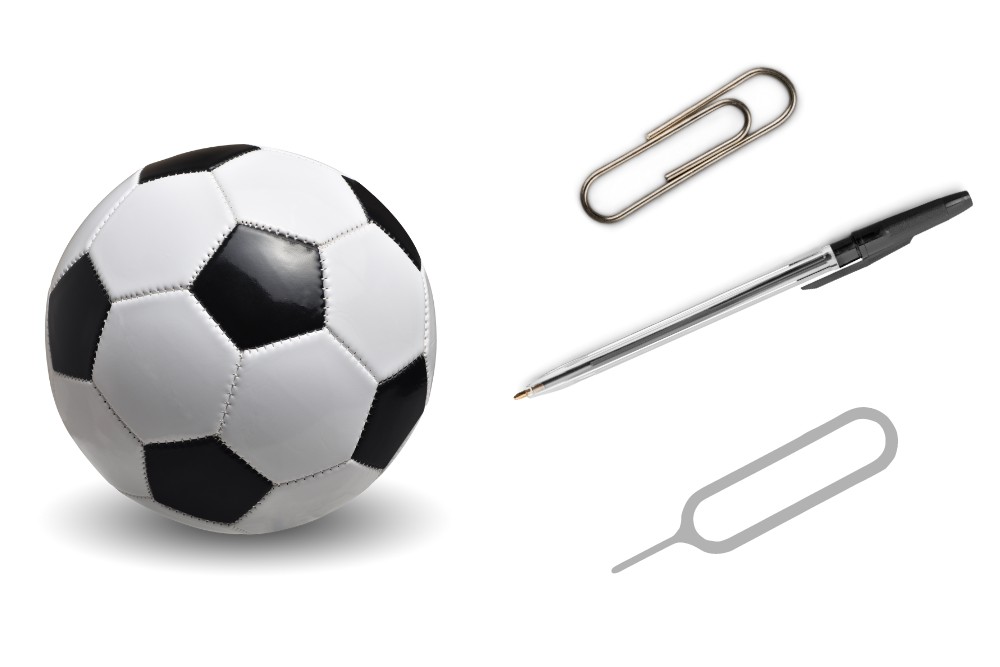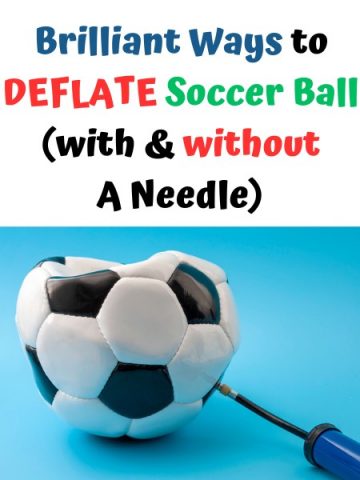Soccer players and enthusiasts of the game know the importance of carrying their soccer balls wherever they go. However, packing an inflated ball can present some challenges.
It takes up precious space in your bag and airlines do not allow inflated balls. This is because the pressure changes during a flight can cause the ball to pop. But that is not the only reason why you should deflate a soccer ball.
Key Takeaways
- Soccer balls must be deflated before taking it into an airplane to avoid an explosion of the ball
- Soccer balls can be deflated using the pin that comes with the ball
- In the absence of the official soccer pin, you can use an office file pin to deflate the ball
There are myriad reasons why people may want to deflate their soccer ball besides just taking it on a journey. Sometimes it may be because the ball has been overinflated which leads to an awkward bounce.
It is also highly recommended that soccer balls should be deflated when they are to be stored for a long time. This relieves pressure and allows the ball to remain in good shape for an enjoyable playing experience.
While there are many ways of deflating the soccer ball, not all of them are safe for your ball. Some will ruin the valve making it difficult for you to use the ball again until you get it fixed.
Read through this guide before trying any other trick on how to deflate a soccer ball because we are going to bare the right ways of doing it and the consequences of doing it the wrong way.
Quick Navigation
How to deflate a soccer ball?
According to FIFA, size 3, 4, and 5 soccer balls must be inflated from 8.5 PSI to 15.6 PSI. Outside this range, the soccer ball cannot be used for official games.
A ball that is underinflated is harder to play and will not travel far when kicked. Also, it will drag more on the surface rather than roll which will also hasten the wear of the outer panel.

On the other hand, an overinflated ball will have an awkward bounce and may even explode when kicked. Either way, the playing experience will not be the same.
There are a few unofficial ways of deflating the soccer ball. However, when using these techniques, you need to be extremely careful to avoid causing irreparable damage to the ball.
A leaking valve may be an easy fix, but a damaged bladder or core will be harder to fix. In severe cases, you may have to get rid of the ball and buy a new one—and that will cost you.
The bladder is arguably the most important part of the ball because it holds the air. The outer panel you see is just a protection for the bladder.
To safely deflate the ball without affecting the bladder, the air has to be let out slowly and evenly. Below are three ways you can deflate soccer balls and the pros and cons of using each method.
Use a pump needle
Most soccer players will usually have a pump that they use to inflate the soccer ball before taking it out for a game or training session.

Pumps come with needles that are supposed to be inserted into the soccer ball to let in air.
- Complete pump kit: includes a 7.4” pump with flexible extension hose, inflation needles and...
- Inflation gauge: The heavy duty pressure gauge measures psi to make sure you are inflating to the...
- Needles included: Includes 3 needles for pumping up all sizes of soccer balls, footballs,...
Last update on 2023-11-11 / Affiliate links / Images from Amazon Product Advertising API
That needle can also be used to let the air out when need be. Follow the steps below to deflate your soccer ball using a pump needle.
- Locate the valve on the ball. It should be a black spot somewhere on the panel that is made of a material that is stronger than the panel (usually tough silicone)
- Take the pump needle and moisten the tip using a lubricant, water, oil, or saliva (when there is no close alternative)
- Insert the needle into the valve. Oil-based lubricants will help the needle to glide more easily into the valve and push down until you get to the bladder. You should hear air hissing out of the ball
- Hold the needle in and squeeze the ball gently and evenly with your other hand.
- Once the ball is deflated to your satisfaction, remove the needle.
This is the safest method for deflating the soccer ball. The odds that you will damage anything are slimmer. Therefore, it is the recommended technique for amateurs.
NOTE: Don’t try to force all the air out at once or you risk damaging the bladder. Also, make sure you hold firmly onto the needle throughout the entire process or the needle may fly out of the valve.
Improvise with everyday objects
It’s highly unlikely that you will carry your pump and pin anywhere you go with your soccer ball. But what if there is a need that requires you to deflate your soccer ball?
For example, hurrying to the airport to avoid missing your flight only to be told that you cannot take your soccer ball in unless it is deflated. In such instances, you may have to improvise using everyday objects.
Any object that is hard, pointy, and long enough to penetrate the valve and get into the bladder will cause air to escape from the bladder.

From paper clips to pens to your smartphone sim ejector pin, you can experiment with just any object that fits the description.
- ASSORTED SIZES - 750 pcs Paperclip Assorted Sizes includes 50 Jumbo Paper Clips of 2”, 150 Paper...
- NON TEARING - Paper clip smooth finish & edges will not rip or mark documents
- DURABLE & RUST RESISTANT COATNG - Hard wearing nickel coating on paper clips large will not flake...
Last update on 2023-11-10 / Affiliate links / Images from Amazon Product Advertising API
Before inserting any object into the valve, make sure that the object is a bit smaller in diameter than your valve and maintains that diameter throughout its length. The use of tapered objects to deflate soccer balls is highly discouraged.
This is because in tapered objects, the slimmest part will easily go in but you may find yourself forcing the wider part to go as you attempt to reach the bladder—which may perpetually damage the valve.
However, the most popular pin alternative that many people use is a paper clip. The description below will talk about how to use a paper clip but it still applies to every other object.
- For a metal paper clip, you need to unwind one of the ends to create a shape that looks like an L. The big or medium size paper clip is preferable to the small one
- Lubricate the pointed end of the paper clip. The use of an oil-based lubricant is preferable in this case
- Hold the other end of the clip firmly. You may need a rag to achieve this considering the slippery nature of paper pins
- Insert the lubricated end of the paper clip into the valve and push gently down until you hear the hissing sound
- Hold it firmly in that position and gently squeeze the ball to let out the air
- Remove the paper clip when the ball has deflated to your desired size
With improvised objects, it only takes one wrong move to ruin your entire soccer ball. This technique should be left for the professionals—except you don’t mind changing your ball if anything goes wrong.
Rely on the forces of nature
There is another way to deflate your soccer ball that is not always mentioned because it is more of an experimental technique. In this case, you don’t need a ball pump pin or any other similar object. You only have to rely on the forces of nature to get the air out of the ball.
Objects and gases—including air—expand when heated and contract when cooled. So, chilling your soccer ball will force it to contract which will force some air out of the ball. The process of doing this is simple.
- Take your ball and clean it to make sure there is no dirt or debris stuck to it
- Wrap the ball in a dish towel
- Place the wrapped ball in your refrigerator and leave it there for about 12 hours
- Remove it after the time elapses
NOTE: This is purely an experimental process and you can try it and be amazed by your result. However, when using this technique, there are a few things that you need to know:
- You have no control over how much air will be let out of the soccer ball.
- The soccer ball will be partially deflated.
- You can only archive partial deflation with this method and the ball will freeze if you keep it in the refrigerator for too long.
- Repeatedly doing this can damage the bladder of the soccer ball. This is because the bladder will become stiffer and less flexible when frozen which makes it easier for it to pop.
- The external panel can also disintegrate from the impact of the freezing—especially for molded panels.
Conclusion
Occasions will always emerge where we need to deflate soccer balls. Whether it is jumping on an airplane or storing the balls for extended periods, they need to be deflated for safety or to preserve the integrity of the soccer ball.
The safest means of letting the air out of a soccer ball is to use a pump needle. However, in the absence of this needle, you can experiment with other firm objects with diameters smaller than the valve of your soccer ball.
The most fascinating way of letting the air out of the ball remains the use of a refrigerator. However, while using this technique you should always bear in mind that it is not safe and can affect the health of your ball—but who says you cannot experiment with old balls? Have fun!
Hi there, I’m Jay.
Soccer is everything in my life! My friends and I have created this blog with all our enthusiasm, passion, and understanding after years of playing pro soccer. Hope you will enjoy it!


